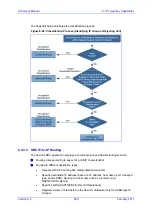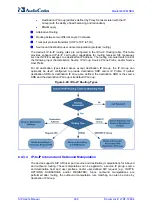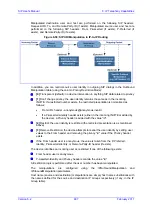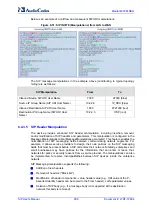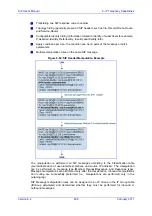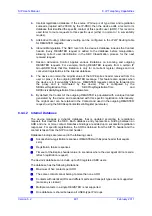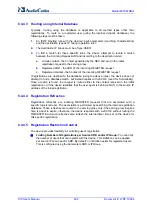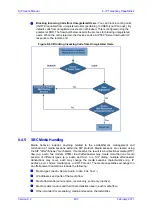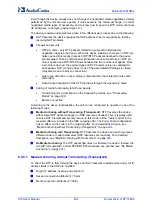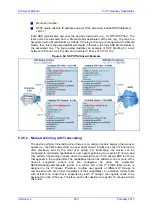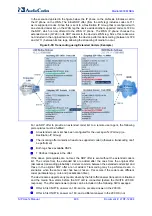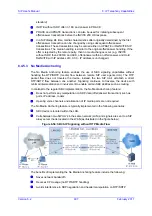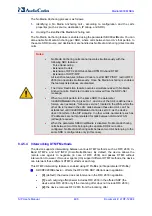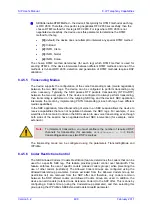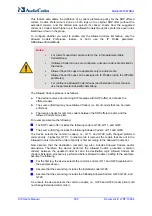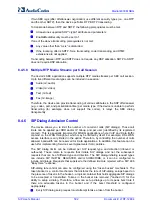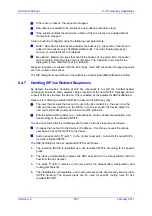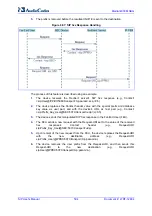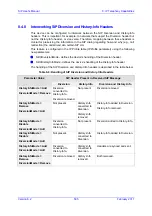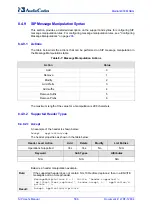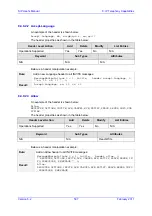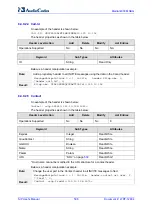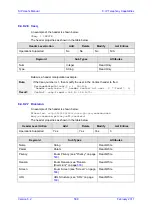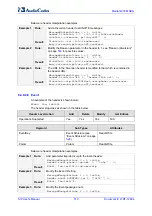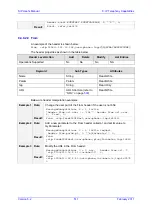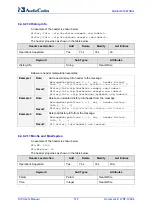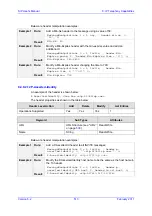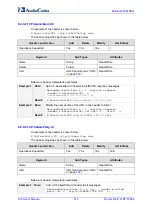
Version 6.2
499
February 2011
SIP User's Manual
8. IP Telephony Capabilities
SBCAlternativeDTMFMethod – the device's first priority for DTMF method at each leg
is RFC 2833. Therefore, if a specific leg negotiates RFC 2833 successfully, then the
chosen DTMF method for this leg is RFC 2833. For legs where RFC 2833 is not
negotiated successfully, the device uses this parameter to determine the DTMF
method for the leg.
•
[0]
(default): the device does not attempt to interwork any special DTMF method
•
[1]:
In Band
•
[2]:
INFO, Cisco
•
[3]:
INFO, Nortel
•
[4]:
INFO, Korea
The chosen DTMF method determines (for each leg) which DTMF method is used for
sending DTMF’s. If the device interworks between different DTMF methods and one of the
methods is In-band\RFC 2833, detection and generation of DTMF methods requires DSP
allocation.
8.4.5.5 Transcoding Modes
The device supports the configuration of the voice transcoding mode (media negotiation)
between the two SBC legs. The device can be configured to perform transcoding only
when necessary. Typically, the SBC passes RTP packets transparently (RTP-to-RTP)
between the two user agents. If the device is configured to always perform transcoding,
then transcoding is performed on the outgoing SBC leg and the device's SBC application
interworks the media by implementing PSTN transcoding (since both legs have different
media capabilities).
In the SBC application, forced transcoding of voice in an SBC session allows the device to
receive capabilities that are not negotiated between the SBC legs. For example, if one
would like to force Gain Control on the SBC session to use voice transcoding, even though
both sides of the session have negotiated without SBC intervention (for example, coder
extension).
Note:
To implement transcoding, you must configure the number of required DSP
channels for transcoding (for example,
MediaChannels = 120
). Each
transcoding session uses two DSP resources.
The transcoding mode can be configured using the parameters TranscodingMode and
IPProfile.
8.4.5.6 Coder Restrictions Control
The SBC Allowed Coders (Coders Restriction) feature determines the coders that can be
used for a specific SBC leg. This feature provides greater control over bandwidth. This
feature enforces the use of specific coders (
allowed coders groups
) while preventing the
use of other coders (restricted). The Allowed Coders Groups are configured using the
AllowedCodersGroup parameter. Coders excluded from the Allowed Coders Group list
(restriction list) are removed from the SDP offer and therefore, only coders common
between the SDP offered coders and Allowed Coders Group are used. In addition, the
device can add coders (referred to as
Extension Coders
) to the SDP offer. This is done by
configuring a Coders Group (using the CodersGroup parameter), and then selecting this
group using the IP Profile's SBCExtensionCodersGroupID parameter.
Содержание Mediant 800 MSBG
Страница 2: ......
Страница 366: ...SIP User s Manual 366 Document LTRT 12804 Mediant 800 MSBG Reader s Notes ...
Страница 372: ...SIP User s Manual 372 Document LTRT 12804 Mediant 800 MSBG Reader s Notes ...
Страница 390: ...SIP User s Manual 390 Document LTRT 12804 Mediant 800 MSBG Reader s Notes ...
Страница 404: ...SIP User s Manual 404 Document LTRT 12804 Mediant 800 MSBG Reader s Notes ...
Страница 616: ...SIP User s Manual 616 Document LTRT 12804 Mediant 800 MSBG Reader s Notes ...
Страница 636: ...SIP User s Manual 636 Document LTRT 12804 Mediant 800 MSBG Reader s Notes ...
Страница 652: ...SIP User s Manual 652 Document LTRT 12804 Mediant 800 MSBG Reader s Notes ...
Страница 886: ...SIP User s Manual 886 Document LTRT 12804 Mediant 800 MSBG Reader s Notes ...
Страница 890: ...User s Manual Ver 6 2 www audiocodes com ...

